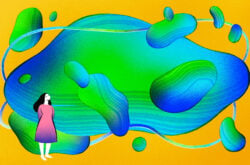Illustration: Leo Peng
Arpeggios are an incredible musical tool that can be used in a wide array of contexts.
Much like with triads, a fundamental understanding of arpeggiation can significantly open up one’s compositional skills and improvisational abilities. In this article, we break down what arpeggios are, the basic types, some advanced applications, and how to use them in your music.
What are arpeggios?
An arpeggio takes the individual notes which make up a given chord and plays them successively in ascending and / or descending order (rather than simultaneously or with a strumming action). While arpeggios are constructed by as few as three individual pitches, their usage regularly spans across at least two octave ranges of each, creating a flowing sound which can feel much more like a playing a scale than playing a single chord. This is a reason why arpeggios can also be referred to as broken chords.
Many MIDI keyboards today boast some type of arpeggiation mode, including one of the most common pieces of starter hardware for producers in the MPK Mini. In this case, the idea of breaking up a chord is made incredibly clear, as by simultaneously holding down as few as two keys, the player will hear the individual notes played in steps at a set tempo. More advanced synthesizers and MIDI instruments can create far more complex arpeggiated pathways, such as the Arturia MicroFreak used in an example below.
How arpeggios are played
Outside of MIDI, the usage of arpeggios in live performance is commonly associated with stringed instruments in classical and jazz styles. We may consider the root of the word itself, which derives from arpeggiare in Italian, meaning “to play a harp,” which in itself evokes the rhythmic, swift plucking of chords on the instrument. Here’s also to hoping that this may inspire a few metal guitarists out there to start honoring the instrument which brought them their cherished sweep picking—at a minimum, wouldn’t smashing a harp be just as much (if not more) fun than smashing a guitar?
Speaking of which, in addition to the harp and piano, the guitar is undoubtedly one of the most well-known stringed instruments that’s particularly well-equipped to showcase arpeggiation. This is exemplified quite well here by Ichika Nito, though most often guitars and arpeggios are associated together through the aforementioned method of sweep picking. Also called “sweeping” and quite popular in metal and metal-adjacent genres, this approach to broken chords rapidly spits out the determined notes across the six strings of a guitar while the player largely maintains the same fretboard position. The movement is visually very vertical, whereas playing arpeggios on a piano would call for a lot of side-to-side movement depending on the number of keys and how many octaves the player is traversing.
Examples of arpeggios: Major, minor, augmented, and diminished
If you’re a listener of groups like Polyphia or Daft Punk, your ears are likely already quite attuned to the use of arpeggios. To get acquainted with their sound, let’s start by having a listen to a basic major arpeggio performed on a nylon string guitar.
E major arpeggio at varying lengths, beginning on the open low E string
We opted for the key of E, since this allows for a number of open strings and also lets us use nearly the entire range of the six-string, 19-fretted instrument. A standard guitar could actually continue even higher to hit another third and fifth; in E, the fretboard allows for a full four octaves of every note, just a few frets short of a fifth octave! Quite cool, and those of you with professional keyboards, grand pianos, and so on can certainly broaden the range even beyond that.
Now, let’s also hear some examples of minor, augmented, and diminished arpeggios:
E minor arpeggio at varying lengths, beginning on the open low E string
E augmented arpeggio at varying lengths, beginning on the open low E string
E diminished arpeggio at varying lengths, beginning on the open low E string
Arpeggiating more complex chords
What becomes really interesting here is that, when exploring arpeggios, there’s one more type that goes well with any given key: the dominant seventh arpeggio. This chord is typically constructed from the 5th degree of a scale, embellishing the major triad with a minor seventh on top. This provides an incredibly distinct chord to be creative with in compositions, and sounds like this when arpeggiated:
E dominant 7th arpeggio at varying lengths, beginning on the open low E string
If you want to build further upon this foundation, you can take using arpeggios to yet another level with modes, where you may find even more uses for things like dominant sevenths.
Major seventh and minor seventh arpeggios
Let’s take this a step further. If there are arpeggios that use more than the core three notes in a triad, such as the dominant seventh chord above, what other notes within a scale can we arpeggiate?
For starters, we can build upon our dominant seventh example by also considering minor seventh and major seventh chords. With a root of E, those are build like so:
| E dominant 7th | E | G♯ | B | D |
| E major 7th | E | G♯ | B | D♯ |
| E minor 7th | E | G | B | D |
If you play a major seventh arpeggio on your instrument of choice, you may notice it resembles a particular TV theme—have a listen to a deep dive on this via Nick Chen below:
Here’s another example, with the primary guitar hook performing an Fmaj7 arpeggio:
Suspended arpeggios
In addition, there are other arpeggios that differ from what we’ve looked into thus far, despite also only using three notes across each octave. One example of this would be a suspended arpeggio, which uses either the second or the fourth of the scale degree rather than a major or minor third.
Arpeggios in action
Here’s something I whipped up in the key of F, using major and minor seventh chords with some extra sauce in there:
Recorded on the Arturia MicroFreak, utilizing the Ceramic & Clay Orchestra sample pack
Here, I let the MicroFreak do the work before resampling various one-shots, which resulted in quite the nice foundation for a future ambient track. To me, prompts like this can make the difference between not knowing where to start and not knowing how to stop with a track—a true key to accessing creative flow, with your favorite instruments and samples around to join the fun.
Arpeggiation beyond Western music theory
Often, many of us focus on the concepts pertaining to Western music theory, with 12 chromatic steps and topics like triads and arpeggios. There are some instrumentalists, like a friend of this writer who studies the Ney, who may read this and feel it’s not quite written in their musical language. Have a listen:
A minor arpeggio performed on the Ney by Omar Abozekry
An improvised Ney performance by Omar Abozekry, with a pentatonic focus.
There are over 50 known musical modes, or Makams, rooted in Turkish and Arabic music. The aforementioned idea of the chromatic scale doesn’t quite apply here, as instruments are often utilizing intervals between notes far smaller than a half step.
So, as we discuss what arpeggios are natural across specific scale degrees, modes, and more, there are—as there always seem to be—deeper layers to consider, which we’ll perhaps explore in a separate post in the future. If this sounds interesting to you, please reach out with your suggestions, questions, and more via the details below!
Conclusion
We hope that you take these principles, questions, and challenges back to your own instrument(s) and find joy in the continued learning and experimentation around arpeggiation. If you’re interested in integrating arpeggios into an upcoming project, or having some fun kicking off a new idea through a sample, check out the Splice Sounds library If you don’t yet have the experience or access to the gear required to synthesize something new, a simple “arpeggio” search in the library heeded over 2,600 results at the time of this article being written!
Finally, if you enjoyed this guide, please let us know! You can contact me (Matt) regarding this or any of my pieces at mattbrooks.beratung@gmail.com, and join the Splice Discord to engage in conversations and share works-in-progress with a vibrant community of other music creators.
Explore royalty-free melodies, chord progressions, and grooves by key, BPM, genre, and more:
July 21, 2023



